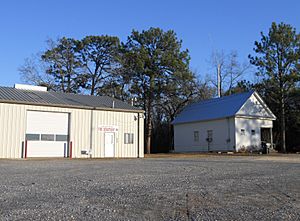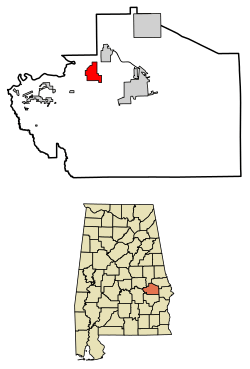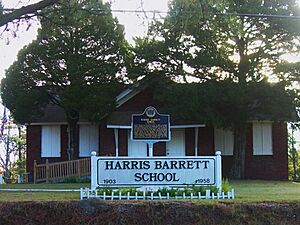Franklin, Alabama facts for kids
Quick facts for kids
Franklin, Alabama
|
||
|---|---|---|

Franklin Volunteer Fire Department and Town Hall
|
||
|
||

Location in Macon County, Alabama
|
||
| Country | United States | |
| State | Alabama | |
| County | Macon | |
| Area | ||
| • Total | 15.11 sq mi (39.14 km2) | |
| • Land | 15.07 sq mi (39.04 km2) | |
| • Water | 0.04 sq mi (0.10 km2) | |
| Elevation | 220 ft (70 m) | |
| Population
(2020)
|
||
| • Total | 590 | |
| • Density | 39.1/sq mi (15.11/km2) | |
| Time zone | UTC-6 (Central (CST)) | |
| • Summer (DST) | UTC-5 (CDT) | |
| FIPS code | 01-28024 | |
| GNIS feature ID | 0156379 | |
Franklin is a small town located in Macon County, Alabama, in the United States. In 2020, about 590 people lived there.
Contents
Franklin's History and Schools
The land where Franklin is located was once home to the Muscogee (Creek) people. They grew important crops like corn, squash, and beans, which they called the "Three Sisters." They also grew tobacco for special ceremonies.
Early Life and Leaders
A famous leader named Osceola (1804-1838) was born near here. He became well known for leading the Seminole people in Florida. Osceola's mother was Creek, and the Creek people trace their family through the mother's side.
For over 200 years, Franklin has had many churches. In the late 1700s and early 1800s, a Methodist church worked with the Creek people here. It had two cemeteries, one for white settlers and one for the Creek. James McQueen, a Scottish trader who lived here and married a Creek woman, was Osceola's great-grandfather. He is buried in the Creek cemetery.
Farming and Changes
Later, the Creek people were forced to give up their lands. European Americans then started growing cotton in the area. They used the hard work of enslaved African Americans, who were often brought from other parts of the country. Cotton remained the main crop even after the Civil War.
Franklin's Schools and Community
The Franklin School started in the 1890s for white students, teaching grades 1 through 11. By the mid-1930s, it taught grades 1 through 6. The school had two classrooms connected by a shared hall. Students got water from a spring or a hand pump. A wood-burning stove kept the school warm, and each student brought a stick of wood every morning.
The school closed in 1942, and its 75 to 80 students went to schools in Tuskegee. After the school closed, one of its classrooms became a community center. The rest of the school building was taken down.
In the middle of the 1900s, the famous musician Hank Williams Sr. often played at dances at this community center. When Franklin officially became a town in 1977, the community center building became the town hall.
Harris Barrett School
The Harris Barrett School was built in 1903. Its bricks were made by hand by students from the Tuskegee Normal School (now Tuskegee University), under the guidance of Booker T. Washington. This school was for African-American students, many of whom were descendants of formerly enslaved people.
Both the Harris Barrett School and the Tuskegee Institute were very important for education in Franklin. They even had an experimental farm nearby. Booker T. Washington and George Washington Carver were active in farming in Franklin and helped both Black and white farmers. Today, the Harris Barrett School has been fixed up and is a historic museum.
Franklin's Geography
Franklin is located at 32°27′19″N 85°48′10″W / 32.45528°N 85.80278°W. The town covers an area of about 3.34 square miles (8.65 square kilometers), and all of it is land.
Population of Franklin
| Historical population | |||
|---|---|---|---|
| Census | Pop. | %± | |
| 1970 | 173 | — | |
| 1980 | 133 | −23.1% | |
| 1990 | 152 | 14.3% | |
| 2000 | 149 | −2.0% | |
| 2010 | 149 | 0.0% | |
| 2020 | 590 | 296.0% | |
| U.S. Decennial Census 2013 Estimate |
|||
In 2000, there were 145 people living in Franklin. By 2020, the population had grown to 590 people.
Who Lives in Franklin?
According to the 2020 census, most people in Franklin (about 80%) were Black or African American. About 16% were White. A small number of people were of other races or mixed races. About 1.36% of the population identified as Hispanic or Latino.
In 2000, the average household had about 2.33 people. About 28% of households had children under 18. The median age in the town was 47 years old.
See also
 In Spanish: Franklin (Alabama) para niños
In Spanish: Franklin (Alabama) para niños



